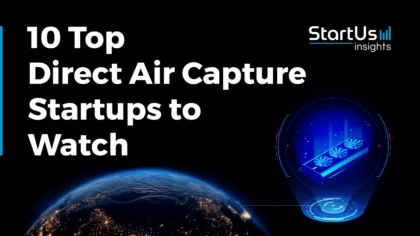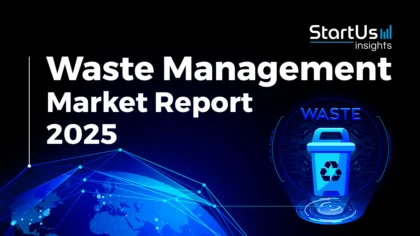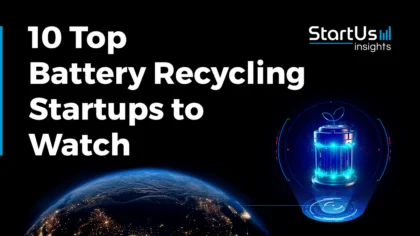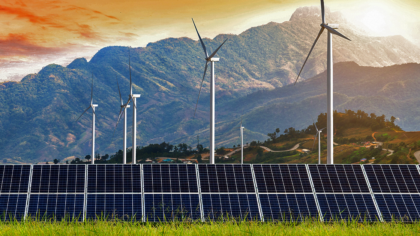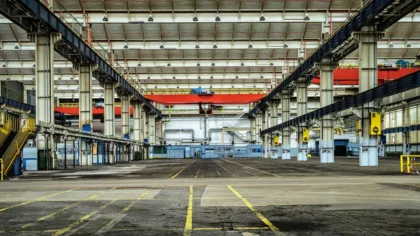Accelerate Productivity in 2025
Reignite Growth Despite the Global Slowdown
The global population is increasing at a steep rate, far outpacing available resources in the traditional “take-make-waste” approach of the linear economy. This is why there is a shift towards a circular economy. Solutions that aim to reduce waste and the use of new raw materials enable the establishment of a closed-loop economy. Thus, circular economy solutions turn waste into resources and extend the life of products and materials. For this, startups and smart cities are turning to technologies like Artificial Intelligence (AI), the Internet of Things (IoT), and blockchain, making them integral aspects of circular economy trends.
This article was last updated in August 2024.
What are the Top Circular Economy Trends (2025)?
Innovation Map outlines the Top 8 Circular Economy Trends & 16 Promising Startups
For this in-depth research on the top lighting industry trends and startups, we analyzed a sample of 3964 global startups & scaleups. This data-driven research provides innovation intelligence that helps you improve strategic decision-making by giving you an overview of emerging technologies in the circular economy industry. In the Circular Economy Innovation Map, you get a comprehensive overview of the innovation trends & startups that impact your company.
These insights are derived by working with our Big Data & Artificial Intelligence-powered StartUs Insights Discovery Platform, covering 4.7M+ startups & scaleups globally. As the world’s largest resource for data on emerging companies, the SaaS platform enables you to identify relevant technologies and industry trends quickly & exhaustively.
Want to explore all Circular Economy innovations & trends?
Tree Map reveals the Impact of the Top 8 Circular Economy Trends
Based on the Circular Economy Innovation Map, the Tree Map below illustrates the impact of the Top 8 Circular Economy Trends in 2025. With the alarming rise of waste and carbon emissions, effective waste management is critical to reducing the environmental impacts of economical activities. Solutions include generating resources from waste, optimized waste collection with IoT, and AI-powered waste sorting.
Startups also use AI to predict demand for reducing the wastage of perishable products and food items. Keeping products in the loop for as long as possible is another major principle of the circular economy. Hence, startups are also working on sustainable practices like reusing, repairing, and remanufacturing products. Blockchain furthers circularity by enabling product traceability and reward systems for positive behaviors, like disposing of waste in the correct bins.
Global Startup Heat Map covers 3964 Circular Economy Startups & Scaleups
The Global Startup Heat Map below highlights the global distribution of the 3964 exemplary startups & scaleups that we analyzed for this research. Created through the StartUs Insights Discovery Platform, the Heat Map reveals that Western Europe is home to most of these companies while we also observe increased activity in the US as well as Asia, particularly in China & India.
Below, you get to meet 16 out of these 3964 promising startups & scaleups as well as the solutions they develop. These 16 startups were hand-picked based on criteria such as founding year, location, funding raised, and more. Depending on your specific needs, your top picks might look entirely different.
Top 8 Circular Economy Trends in 2025
1. Waste-to-Resource
The world generates tonnes of waste annually, most of which end up in landfills. The circular economy retains the value of products or resources by putting them back into the product cycle after use. Besides mechanical recycling, one of the biggest circular economy trends is to upcycle this waste to energy by incineration, gasification, anaerobic digestion, and pyrolysis. This allows waste management companies to get rid of the waste effectively as well as provide an additional stream of clean energy for power utilities.
While every industry produces waste, some industries, like energy, food, agriculture, and fashion, are larger contributors than others. Startups are working on waste upcycling solutions that focus on waste from such polluting industries. For instance, the fashion industry is now upcycling textile waste to produce new apparel, shoes, and accessories. This reduces the cost of raw materials and makes companies more sustainable.
WAIR produces Sneakers from Textile Waste
Danish startup WAIR collects textile waste, namely jeans and workwear, and upcycles them into vegan and sustainable sneakers. It manufactures soles from eco-rubber that comprises 70% recycled rubber and 30% virgin rubber. The startup uses plant-based materials and recycled cotton to make insoles and laces, respectively. When the shoes reach the end of their lifecycle, the startup shreds and reuse them as input for new products.
SEaB Energy offers Waste-to-Energy Solutions
SEaB Energy is a UK-based startup that offers solutions to generate on-site energy from waste. The startup’s containerized anaerobic digester, Muckbuster, turns slurry and farm waste into electricity and heat, generating fertilizer as a by-product. The digester converts slurry into biogas which then fuels a Combined Heat and Power (CHP) engine. Similarly, another digester, Flexibuster, turns organic waste, like food waste, into energy by utilizing the same mechanism.
2. Reuse
Reusing products extend their lifecycle while reducing waste and the use of new raw materials, thus, making it one of the top circular economy trends. However, there is often a lack of information about the products available for reuse. To tackle this issue, various types of sharing platforms are on the rise. For instance, asset-sharing platforms allow businesses to earn revenue by lending materials or machines that otherwise mostly remain unused.
Similarly, food-sharing applications reduce food waste while preventing losses from unsold food. Apart from reusing materials, there is a shift away from single-use packaging to reusable packaging. The latter is made with durable materials to survive multiple lifecycles. Reusable packaging is also gaining traction in the manufacturing, automotive, and consumer goods industries. It allows brands and companies to significantly reduce packaging purchase and disposal costs. Additionally, they reduce the carbon footprint by sending less waste to landfills.
Excess Materials Exchange provides an Online Marketplace for Reuse
Excess Materials Exchange is a Dutch startup that offers a Business-to-Business (B2B) digital matching platform for reusing materials or waste products. It assigns a digital identity to the materials or products with barcodes, QR codes, and RFID chips. The digital identity provides an overview of the composition, origin, toxicity, and safety of releasing such materials. The platform then identifies reuse options for the materials based on their financial, environmental, and social value.
VYTAL offers Reusable Packaging-as-a-Service
German startup VYTAL produces reusable food packaging. It makes items like bowls, trays, mugs, and pizza packaging from recyclable polypropylene. The startup also provides a free return system through its mobile application. It allows the consumers to see all restaurants that allow package borrowing or returning. The partner shop employees scan the user’s QR code in the application to verify the digital identity of the returnables. The startup then checks and cleans the returned items in a gastro dishwasher for reuse.
3. Internet of Waste
In traditional waste management systems, municipalities and waste management companies often end up spending a lot of money and effort to collect waste. The collection system usually works on fixed schedules, without considering the trash capacities of dumpsters. As a result, garbage trucks often visit dumpsters that are not yet full or those which overflow with garbage.
Therefore, startups are developing IoT-based smart waste management solutions to reduce the inefficiencies in trash collection. Such solutions leverage sensors, IoT platforms, and mobile applications. Smart bins, for example, transmit real-time fill-level information to waste collectors. This streamlines the pickup process and eliminates inefficient visits to near-empty trash bins, saving time, fuel, and labor.
Recytrust develops IoT-based Digital Weight Scale for Recycling Bins
Greek startup Recytrust develops an IoT-based digital weight scale. When placed underneath a recycling bin, it monitors the weight of the waste, generating alerts when the bin needs to be emptied. It features an RFID access control to identify users and monitor their recycling performance.
The accompanying mobile application provides driving routes and alerts while collecting real-time metrics on the weight of recyclables to be picked up. Moreover, on confirmation of a pickup, it enters a unique tracking code in the ledger that enables tracing of the recyclables’ origin and background proof of circularity reports and certifications.
Ishitva Robotics Systems offers a Smart Waste Bin
Ishitva Robotics Systems is an Indian startup that offers an IoT-enabled smart bin that automatically segregates dry waste like paper, plastics, and cans. Besides having a fill level sensor for trash, it also offers route optimization for waste collection. The dashboard enables the supervisors to monitor assigned devices. The platform also analyzes the waste and generates reports on usage patterns, types and amount of waste collected, and time spent on collecting waste in each area.
4. Artificial Intelligence
Separating or sorting garbage is as important as effective waste collection to ensure that the right materials are sent for recycling. Unfortunately, this process is still a bottleneck for many waste management facilities as the majority of them follow a single-sort system in which all the recyclables end up in the same box. But the recyclables like plastic and cardboard need to be separated.
AI-powered sensors differentiate among items made from different materials as well as nuances among the ones of the same materials. It also detects chemical contamination in the items. This is why the use of AI in waste management is one of the emerging circular economy trends. Moreover, AI-driven machines sort recyclables much faster than humans using computer vision and deep learning algorithms. AI enables waste management companies to reduce the need for manual labor, thus, cutting costs and maximizing efficiency.
RECYCLEYE designs AI-Powered Waste Management Solutions
British startup RECYCLEYE offers automated waste management solutions that utilize AI and robotics. The solution’s algorithms replicate the power of human vision to identify items in waste streams. Recycleye engages in waste sorting with its AI vision system that identifies and classifies all items on waste streams – by material, object, and even brand.
WasteNet, the startup’s visual database of labeled waste items, identifies waste at the brand level. Leveraging AI to power Recycleye’s robotic picker, it adapts to changing waste compositions without any need for retrofit.
Lixo provides an AI Tool for Waste Characterization
Lixo is a French startup that offers hardware and software tools for waste management companies. The startup’s digital twin connects to the waste management infrastructure. The software solution consists of an AI tool that provides a precise view of waste flows, analyzes their composition, and characterizes the waste in real time. A dashboard allows the stakeholders to view key indicators like purity, flow, and downtime.
5. Bio-based Materials
Products made from non-renewable resources largely contribute to environmental pollution and reach the end of their lifecycle very quickly. Therefore, companies are producing new bio-based materials obtained from renewable resources, making it an important circular economy trend. Bio-based materials are generally compostable and easier to recycle, allowing companies and consumers to reduce their carbon footprints. They find applications in packaging, construction, healthcare, and automotive sectors.
For the packaging industry, startups are developing sustainable packaging solutions such as compostable packaging and edible cutlery. Additionally, to reduce the usage of fossil-based plastic, there is a shift towards bioplastics and other materials derived from biomass sources like wood chips, sawdust, recycled food waste, and fungi.
Teysha Technologies develops Sustainable Polymers
UK-based startup Teysha Technologies offers a natural product polycarbonate platform that creates a wide range of sustainable polymers with tunable properties. The platform utilizes hydrolytic breakdowns to produce polymer materials from renewable resources.
The startup utilizes various co-monomers, solvents, and additives to modify the properties of the final polymer network. It creates a variety of final products that vary from hard and stiff materials to soft, which are directly applied to plant machinery.
MOGU produces Eco-Friendly Interior Design Materials from Mycelium
MOGU is an Italian startup that offers mycelium-based materials for interior design. The startup grows strains of mycelium on pre-engineered substrates from agro-industrial residues. By tuning the matrix configuration, it harvests different materials for use in wall panels and floor tiles.
Fungal mycelium acts as a reinforcement to the matrix structure, creating a plastic-free and coherent material composite. At the end of production, an inertization process slowly dries mycelium materials to reduce energy consumption.
6. Remanufacture
Both recycling and remanufacturing reduce solid and hazardous waste, but the former uses more energy to dismantle a product. Moreover, recycling implies breaking down a product to convert it into raw materials that are used for making new products. But remanufacturing involves rebuilding a product to its original condition with reused, repaired, and some new parts, making it as good as new.
Advanced technologies like Laser Metal Deposition (LMD), an additive manufacturing process, not only restore a component but also add extra features for improved performance. This allows Original Equipment Manufacturers (OEMs) to cut down their capital expenditures while also reducing the carbon footprint.
Circular Computing offers Remanufactured Laptops
British startup Circular Computing remanufactures laptops to BS 8887 standards. After dismantling each laptop into its major parts, they repair and repaint covers, palm rests, bezels, and keyboards in matt, gloss, and soft-touch finishes to match the original laptop.
Replacing damaged components is also an integral part of the remanufacturing process. After the process, every laptop undergoes Aiken testing as well as a minimum 3-hour stress test to run the major components at full load. The startup then sells remanufactured laptops with a minimum 12-month warranty.
Resolute Industrial provides Remanufactured Compressors
Resolute Industrial is a US-based startup offering remanufactured screw compressors, reciprocating compressors, and air-cooled chillers. The startup’s engineers inspect each part of the returned compressors to determine suitability for reconditioning and reuse.
It reuses compressor parts that pass the inspection process and uses new parts to make up for the missing components. The remanufactured compressors undergo a bench testing procedure to assure they are ready for service. The startup offers the same warranties, including extended warranties, for remanufactured compressors as new ones.
7. Blockchain
Blockchain secures its position as a top emerging trend by enabling two important functions in the circular economy — providing transparency and traceability, and incentivizing circular behavior. Startups use blockchain’s immutability to verify the origin of products, assuring that they meet their sustainability claims.
For example, The World Economic Forum’s Mining and Metals Blockchain Initiative’s (MMBI) Carbon Tracing Platform (COT) — a unique proof of concept, traces carbon emissions across the supply chain. This enables mining companies to meet Environmental, Social, and Corporate Governance (ESG) demands.
Additionally, rewarding circular consumption and disposal motivate people beyond the obvious but abstract necessity to protect the planet. For instance, startups are compensating people with a sum or reward points for further purchases on returning packages like empty bottles.
Circularise enables Traceability of Materials with Blockchain
Dutch startup Circularise develops blockchain-based solutions for tracing materials across supply chains. The platform allows suppliers, manufacturers, OEMs, and brand owners to create, maintain, and transact digital assets. It also enables suppliers and manufacturers to increase material value by digitizing their materials and making them traceable.
Further, it allows OEMs and brand owners to verify sustainability certifications as well as track carbon footprints and other sustainability metrics of their products. Similarly, it enables the consumers to access information underlying a company’s sustainability claims, thus, establishing trust and reliability.
Circularr offers a Blockchain-based Reward System
Circularr is a UK-based startup that promotes recycling through a decentralized ecosystem built on blockchain. The platform offers rewards for recycling plastic waste via reverse vending machines and collection points, turning plastic into tradable blockchain assets. Every piece of plastic undergoes tracking and tracing until repurposed, ensuring transparency in the recycling process.
The $CIRP token, backed by rPET plastic, serves as a reward — a sustainable currency in Circularr’s NFT marketplace and a tradable asset for goods and services. This unique approach thus simplifies recycling, provides traceability in the industry, and drives environmental change.
8. Repair
Reusing products extend their lifecycle, but products often become unfit for reuse. Repair technology solutions address this, extending the life of products. Moreover, it reduces waste and the use of new raw materials. Take for example the tonnes of electronic waste globally. Repair solutions hold the potential to bring much of it back to the cycle. This is why repair solutions are an important circular economy trend and companies are adopting them to reduce their carbon footprint and save costs on raw materials.
Also, often, direct replacement is not possible for expensive industrial machines due to the unavailability of specific spare parts and the high costs of new equipment. Repair solutions offer a much cheaper alternative for companies while also contributing to circularity.
FixFirst digitizes Repair & Maintenance Services
German startup FixFirst develops software that digitizes repair and maintenance services. The startup also offers platform services that allow customers to use their devices for longer. It enables service providers, device manufacturers, electronics retailers, and insurance companies to provide repair and maintenance services to their end customers. The startup leverages automatic lead qualification, integration with external partners, video inspection, and remote assistance to achieve this.
Veras offers a Repair Station for Clothes
Veras is a Danish startup offering repair services for garments. The startup fixes gaps and deficiencies in clothes like a cracked seam or a missing button. Moreover, it turns unrepairable clothes into new products like transforming a damaged long dress transformed into a top. The startup offers its services as both online and offline recycled clothing stores.
Discover all Circular Economy Technologies & Startups
While these trends in circular economy promote the transition from a linear economy, newer circular economy innovations are also on the rise. For example, immersive technologies like Augmented Reality (AR) and Virtual Reality (VR) reduce the need for physical interactions. It also eliminates the need for traveling, thus, reducing the need for resources such as saving fuel that would have been used.
Food-sharing applications are gaining importance since they prevent food waste. The fashion industry is also turning to circular manufacturing practices to create sustainable leather and other replacement materials for animal products as well as to reduce its dependence on fresh raw materials.
The Circular Economy Trends & Startups outlined in this report only scratch the surface of trends that we identified during our in-depth research. Among others, smart recycling and upcycling as well as new sustainable materials will transform industries as we know them today.
Identifying new opportunities and emerging technologies to implement into your business early on goes a long way in gaining a competitive advantage. Get in touch to easily and exhaustively scout relevant technologies & startups that matter to you.



 WATCH THE VIDEO VERSION
WATCH THE VIDEO VERSION 


